Are you a Quiet Speculation member?
If not, now is a perfect time to join up! Our powerful tools, breaking-news analysis, and exclusive Discord channel will make sure you stay up to date and ahead of the curve.
With the Prerelease out of the way the actual work of exploring Theros: Beyond Death has begun. As Jordan previously noted, there are a number of interesting role players in Theros. However, there don't appear to be any unequivocal home runs. Considering how 2019 went, that's a very nice change; I'd like a chance to finally catch my breath in the wake of Hogaak, Arisen Necropolis and Oko, Thief of Crowns.
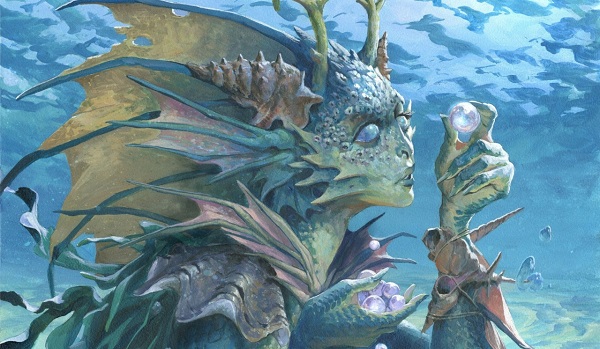
With that in mind, I've already looked at some standout cards, and couldn't find one that didn't have massive setbacks regarding Modern playability. That spirit continues this week, as I examine some more cards that have Modern potential, but may end up not actually being worth the effort. Based on what I've seen from my own efforts and those of others, Theros isn't a block that will unequivocally shake up Modern, but it should disrupt some stagnant decks. And that's more than good enough for me.
Dryad of the Ilysian Grove
Dryad of the Ilysian Grove is Prismatic Omen mixed with Exploration, given legs and with better stats than (but for the same price as) Azusa, Lost but Seeking. A lot of the chatter I've seen on the card has been for Pioneer, where despite 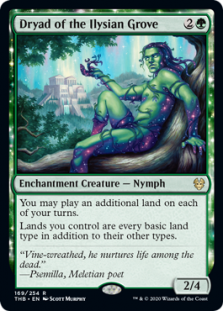 multiple bannings, Mono-Green Devotion remains a top deck. We have Mono-Green Devotion in Modern too, but Leyline of Abundance is still legal here, so it's not interested in a 2/4 enchantment creature.
multiple bannings, Mono-Green Devotion remains a top deck. We have Mono-Green Devotion in Modern too, but Leyline of Abundance is still legal here, so it's not interested in a 2/4 enchantment creature.
I initially saw a few players talking about Dryad as an answer to Blood Moon. But just like with Omen, Dryad and Moon operate on the same layer, so timestamps determine which effect applies. Thus, a Dryad cast after Moon unlocks mana, but cannot preempt the enchantment. And again, Modern already has Prismatic Omen for this purpose.
Even if Dryad did play well against Blood Moon, it wouldn't be played for that purpose. Amulet Titan runs Azusa, and Dryad being more robust makes it appear more attractive. However, Azusa gives two land drops to Dryad's one, and in Amulet that's all that matters. Amulet doesn't care about land types, so Dryad's second ability is superfluous. The deck that actually wants Dryad must not only want additional land drops but care about basic land types.
Dryad Struggles to Belong
Both conditions apply to Valakut. Some pilots were already running Prismatic Omen to make Scapeshift kills faster, so Dryad's chances look good up front; with Omen out, a Scapeshift for six is all that's needed for 18 damage, compared to the seven lands normally required. Ramp spells and additional land drops are functionally the same, and with 28 lands on average, Valakut should theoretically be able to make good use of Dryad.
Unfortunately, Dryad sits in an odd place on Valakut's curve. The deck's usual line is turn one suspending Search for Tomorrow, turn two ramping with Farseek or Sakura-Tribe Elder, hitting five mana on turn three, and dropping Primeval Titan turn four; the Scapeshift kill requires Omen on turn three to kill on turn four. Dryad doesn't much alter either line. Valakut also empties its hand quickly, so the extra land drop will lose impact if not exactly on-curve. And Dryad doesn't find more land or Valakut, making it questionable whether it's better than Omen.
Still, several actual Valakut players I know lost their minds over Dryad, and their investigation is at least suggestive.
Dryad Valakut, Test Deck
Their idea is to treat Dryad as a combination ramp spell and Omen, which frees up some slots now used for Veil of Summer. This configuration is closer to pure combo than to a ramp deck with a combo kill. They've had some success in testing, but part of that is due to other decks still adjusting to the bans.
Valakut's Odd Child
As far as can be determined so far, Dryad is a fine card, but not exceptional in Valakut. Because of how the deck curves out, the kill speed over Omen hasn't noticeably changed. Valakut doesn't have card draw, so Dryad only actually grants one extra land drop before Valakut runs out of cards in hand (maybe two). In terms of actually going off, Dryad is a wash.
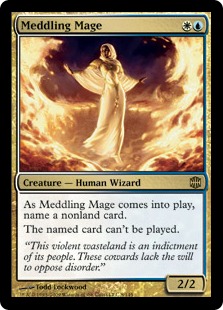 However, Dryad is having an unexpected positive impact on the Humans matchup, and to some extent against midrange thanks simply to being an affordable 2/4. Dryad is a solid wall against Humans that nets some value when resolved. Humans can very narrowly goldfish Valakut since its kill speed is similar, so a persistent road block significantly alters the race. Meddling Mage can still be backbreaking, especially for this Bolt-less version, which means the sideboard is geared against Humans. Against UW decks, Dryad attacks planeswalkers and frequently slips through Jund's discard to put some pressure down or absorb an edict effect to protect Titan.
However, Dryad is having an unexpected positive impact on the Humans matchup, and to some extent against midrange thanks simply to being an affordable 2/4. Dryad is a solid wall against Humans that nets some value when resolved. Humans can very narrowly goldfish Valakut since its kill speed is similar, so a persistent road block significantly alters the race. Meddling Mage can still be backbreaking, especially for this Bolt-less version, which means the sideboard is geared against Humans. Against UW decks, Dryad attacks planeswalkers and frequently slips through Jund's discard to put some pressure down or absorb an edict effect to protect Titan.
I don't think that Dryad will find a home in Valakut based solely on its text box. If pilot want an Omen effect, Dryad can be played in that slot with little effort or change to the gameplan. However, given a need for an actual creature to deal or absorb damage, Dryad is far better than Azusa.
Setessan Champion
In terms of potential archetype churn, there may be no deck more affected by Theros than Bogles. After all, the set's about auras, and Bogles is an aura deck. However, that didn't happen last time we visited Theros. Bogles is a very stagnant deck, and has been throughout Modern's history. Once Wizards realized that hexproof is broken compared to shroud, they stopped printing cheap hexproof creatures, and no aura has approached Ethereal Armor or the Umbra enchantments in power. The most dramatic change I've ever seen the deck make is moving Leyline of Sanctity to the maindeck.
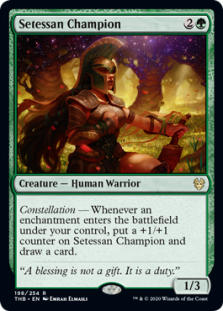 But Setessan Champion may deeply impact the archetype: it doesn't challenge any of the actual one-drop threats, but rather Kor Spiritdancer. Spiritdancer is the card that Bogles likes to cast but never actually enchant. Lacking hexproof, it's actually vulnerable to removal. The only times I've seen it enchanted is when Bogles has no Bogles, or when it's up against combo and needs to accelerate the kill. Spiritdancer is played because it draws cards as a cast trigger; Bogles usually has to mulligan aggressively to find a threat and some good auras, so that card advantage is essential.
But Setessan Champion may deeply impact the archetype: it doesn't challenge any of the actual one-drop threats, but rather Kor Spiritdancer. Spiritdancer is the card that Bogles likes to cast but never actually enchant. Lacking hexproof, it's actually vulnerable to removal. The only times I've seen it enchanted is when Bogles has no Bogles, or when it's up against combo and needs to accelerate the kill. Spiritdancer is played because it draws cards as a cast trigger; Bogles usually has to mulligan aggressively to find a threat and some good auras, so that card advantage is essential.
Champion has some drawbacks compared with Spiritdancer: a higher mana cost and the card draw effect being an enters rather than a cast trigger. Counterspells become stronger and the deck slightly clunkier as a result. However, Champion offers some compensating factors; primarily, it actually does something when not enchanted. Spiritdancer is 0/2 while Champion is 1/3, a stat upgrade substantial in that the Warrior can plausibly attack and block. And unlike Spiritdancer, Champion grows just by playing auras. Bogles can keep loading up its hexproof creatures and still grow Champion. +1/+1 counters will also survive if all the auras get destroyed, leaving behind a real gameplan should Engineered Explosives go off.
Restored to... Glory?
I think that Champion is close enough to Spiritdancer that it's worth reexamining Bogles, especially in light of Theros also bringing Staggering Insight to the table. Bogles asks a lot of its current two-mana enchantments and tries to ride its GW manabase for all its worth, but I've seen Keen Sense in Bogles before. Adding lifelink and +1/+1 is enough of an upgrade to include it, especially in a churning Modern where Burn will be prominent.
Bant Bogles, Test Deck
The mana is still very reliable, and adding blue grants more sideboard options. I haven't noticed much actual impact on matchups during testing, but that may be because I'm sticking close the classic formula. I've seen some Bogles decks online that are barely recognizable. In any case, I haven't felt any negative impact from adding Theros cards and blue, so I'm going to keep working on the deck.
Thassa's Oracle
On the surface, Oracle isn't so flashy; manipulating the top of the library without drawing a card is only playable occasionally in combo decks or when repeatable. But of all the Theros cards I've examined, Thassa's Oracle has the most clear home.
The second part of Oracle's text turns it into a win condition, albeit a tough one to trigger. Assuming, of course, that the condition is being met the "correct way," with lots of blue permanents in play. It's much easier to just Oracle with an empty library. And there happens to already be a deck in Modern that does exactly that.
Ad Nauseam, Test Deck
Ad Nauseam decks have traditionally run Laboratory Maniac as an alternative to Lightning Storm, though some have recently opted for Jace, Wielder of Mysteries. In either case, since Ad Nauseam draws its entire deck, playing Maniac and Serum Visions or using Jace's +1 won the game. While a decent way around Leyline of Sanctity, these options cost a minimum of four mana on the combo turn. Oracle does the same job, only requires one card, and is two mana. Thus, Oracle is a straight upgrade and replacement for the previous options.
An Answer with More Questions
A singleton upgrade for a fairly niche deck might not be enough to warrant much discussion. But the more general application of a self-contained Laboratory Maniac is.
At the beginning of spoiler season, it looked like Underworld Breach would the Modern card. Breach, Grinding Station, and any 0-CMC artifact mills the entire library. Escaping Mox Opal repeatedly generated mana, building into either Grapeshot or Banefire on turn three. Of course, Opal was banned immediately thereafter, making that deck dead-on-arrival.
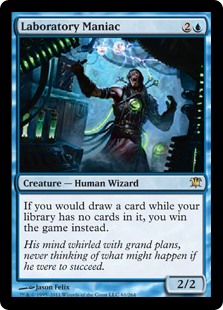 However, the combo still mills a whole library. And it costs less than Ad Nauseam, even if it is spread out over two cards. As Dredge has repeatedly shown, milling an entire library is very powerful. I have been trying to find a use for the combo, and Thassa's Oracle is the obvious win condition. As a bonus it can also scry towards missing pieces and block if necessary. Just make sure to have one in hand before comboing off. The main problem has been that to get everything together consistently and quickly I've been building decks that are effectively more elaborate versions of traditional Ad Nauseam. And more elaborate combos is not where a combo deck wants to be. I think this is solvable by thinking more outside the box with card choices, so it's worth pursuing.
However, the combo still mills a whole library. And it costs less than Ad Nauseam, even if it is spread out over two cards. As Dredge has repeatedly shown, milling an entire library is very powerful. I have been trying to find a use for the combo, and Thassa's Oracle is the obvious win condition. As a bonus it can also scry towards missing pieces and block if necessary. Just make sure to have one in hand before comboing off. The main problem has been that to get everything together consistently and quickly I've been building decks that are effectively more elaborate versions of traditional Ad Nauseam. And more elaborate combos is not where a combo deck wants to be. I think this is solvable by thinking more outside the box with card choices, so it's worth pursuing.
The potentially fatal problem for the deck is the combo itself. This is an all or nothing combo with a very narrow usage. All the milled cards have to be exiled to keep the loop going, so typical graveyard shenanigans don't work. Firing off a full set of Creeping Chills sounds good, but if triggered then they can't be exiled to pay for escape. Same with creatures like Narcomoeba. To get value from milling my deck, I need to stock the graveyard with fodder first, which defeats the point of the combo. It doesn't generate any mana either, so there's no way to combo off except with Oracle. Ad Nauseum technically does, because it finds Simian Spirit Guide. The combo is built to exile the library, and does so efficiently, but it can't do anything else.
But What Does it Mean?
Everything I've found so far has been more intriguing than obviously good, and none of it has clearly won a place in Modern. However, I can't dismiss these cards, either. It's like there are pieces that I can't quite grasp when solving this puzzle. I intend to keep working on the solutions, but if you've had any success, please share in the comments.




